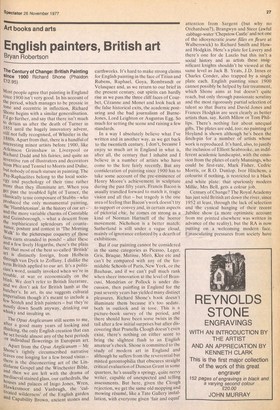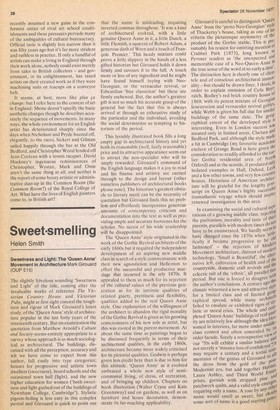Art books and arts
English painters, British art
Bryan Robertson
The Century of Change: British Painting since 1900 Richard Shone (Phaidon 12.95) Most people agree that painting in England since 1900 isn't very good. In his account of the period, which manages to be prosaic in tone and eccentric in inflection, Richard Shone begins with a similar generalisation. I'd go further, and say that there isn't much to detain us after the death of Turner in 1851 until the hugely innovators' advent, Still not fully recognised, of Whistler in the 1880s. Apart from that, there is a handful of interesting minor artists before 1900, like Atkinson Grimshaw in Liverpool or Richard Dadd and his fairies, and quite an inventive run of illustrators and decorators from Phiz and Tenniel to Morris and Dulac, but nobody of much stature in painting. The Pre-Raphaelites belong to the local socio°gY and psychology of their time rather More than they illuminate art. When you get past the troubled light of Turner, the classically tense composure of Stubbs—who Produced the only monumental painting, the 'Hambletonian', in the history of our art — and the more variable charms of Constable and Gainsborough, — what a descent from t„tie sophisticated splendours of counteance, posture and context in 'The Morning walk' to the picturesque coquetry of those farm carts stranded in ponds! — after these and a few lively Hogarths, there's the plain fact that most of the best so-called 'British' !,11 is distinctly foreign, from Holbein "trough van Dyck to Zoffany. I dislike the term British applied to our art. It's a politician's word, usually invoked when we're in rouble, at war or economically on the blink. We don't refer to British literature, and we don't ask for British lamb at the utcher's. In art, its use suggests cultural Imperialism though it's meant to include a ieW Scotch and Irish painters — but they're mostly down South anyway, drinking our whisky and insulting us.
The Opus Anglicanum still seems to me, after a good many years of looking and t.hinking, the only English creation that can ne set beside almost any of the best periods °r individual flowerings in European art. Apart from the Opus Anglicanum — Mr iSlkine's tightly circumscribed narrative (eaves One longing for a few broad vistas — there is the disconcerting art of the Lindisfarne Gospel and the Winchester Bible, and then we are left with the drama of mediaeval stained glass, our cathedrals, the 11, Puses and palaces of Inigo Jones, Wren, rlawkesmoor and Vanbrugh, the 'cultivated wilderness' of the English garden and Capability Brown, ancient stones and earthworks. It's hard to make strong claims for English painting in the face of Titian and Rubens, Raphael, Goya, Rembrandt or Velasquez and, as we return to our brief in the present century, our spirits can hardly rise as we pass the three cliff faces of Courbet, Cezanne and Monet and look back at the false historical exits, the academic posturing and the bad journalism of BurneJones, Lord Leighton or Augustus Egg. So much for setting the scene and raising a few standards.
In a way I absolutely believe what I've written and in another way, as we get back to the twentieth century, I don't, because I enjoy so much art in England in what is, after all, the century that I inhabit and I believe in a number of artists who have come to the fore fairly recently. But any consideration of painting since 1900 has to take some account of the pre-eminence of Henry Moore's achievement in sculpture during the past fifty years. Francis Bacon is usually trundled forward to match it, tragic vision and all that — but tragedy is the one area of feeling that Bacon's work doesn't try to support or convey and, in certain aspects of pictorial chic, he comes on strong as a kind of Norman Hartnell of the horror movement. Nicholson is a better match; Sutherland is still under a vague cloud, mainly of ignorance enforced by a dearth of exhibitions.
But if our painting cannot be considered in the same categories as Picasso, Leger, Gris, Braque, Matisse, Miro, Klee etc and can't be compared with any of the formidable Schools of Paris, New York, or the Bauhaus, and if we can't pull much rank when sheer innovation 'at the level of Brancusi, Mondrian or Pollock is under discussion, then painting in England for the past seventy years has yielded many distinct pleasures. Richard Shone's book doesn't illuminate them because it's too sedate, both in outlook and in tone. This is a picture-book survey of the period, and there should have been sonic twists in the tail after a few initial surprises but after discovering that Prunella Clough doesn't even exist, there's nothing on either score to bring the slightest flush to an English amateur's cheek. Shone is committed to the study of modern art in England and although he suffers from the reverential but misted gerontophilia that obscures straight critical evaluation of Duncan Grant in some quarters, he's usually a springy, quite nervy writer, capable of unexpected and telling assessments. But here, given the Clough rejection, we get the same old mopping and mowing resume, like a Tate Gallery installation, with everyone given 'fair and equal' attention from Sargent (but why no Orchardson?), Brangwyn and Steer (awful cabbage-water 'Chepstow Castle' and not one of the idiosyncratic jeune flues en fleurs at Walberswick) to Richard Smith and Howard Hodgkin. Here's a plate for Lavery and there's one for de Laszlo but this isn't a social history and as artists these insignificant knights shouldn't be viewed at the same level as Jack 13. Yeats, J.D. limes or Charles Conder, also trapped by a single plate each. English painting since 1900 cannot possibly be helped by fair treatment, which Shone aims at but doesn't quite reach, but only through passionate scrutiny and the most rigorously partial selection of talent so that Burra and David Jones and Frances Hodgkin are seen clearly as better artists than, say, Keith Milow or Tom Phillips. There's nothing fair about unequal gifts. The plates are odd, too: no painting of Hoyland is shown although he's been the .linchpin for a number of artists whose work is reproduced: It's hard, also, to justify the inclusion of Elliott Seabrooke, an indifferent academic landscapist, with the omission from the plates of early Munnings, who could be first-rate, Mark Fisher, Cedric Morris, or R.O. Dunlop. Ivor Hitchens, a colourist if nothing, is restricted to a black and white plate: that spuriously modern Millie, Mrs Bell, gets a colour job.
Century of Change? The Royal Academy has just sold British art down the river, since 1952 at least, through the lack of selection and the cynical hanging of their recent Jubilee show (a more optimistic account from me printed elsewhere was written in advance of the reality), but the RA is now putting on a welcoming modern face. Emasculating pressures from society have recently assumed a new guise in the conformist antics of rival art school establishments and these pressures pervade many of the ambiguities of cultural bureaucracy. Official taste is slightly less narrow than it was fifty years ago but it's far more strident and ruthless in practice. If only a handful of artists can make a living in England through their work alone, nobody could exist merely from sales to British collectors — and government, in its enlightenment, has taxed artists on their created work as if they were machining suits or teacups on a conveyor belt.
It seems, at best, more like plus got change: but I refer here to the context of art in England: Shone doesn't specify the basic aesthetic changes though he describes accurately the sequence of movements. In many ways, the whole environment for an English artist has deteriorated sharply since the days when Nicholson and Pryde buzzed off, elegantly, to the races. Sickert and Gilman sailed happily through the bar at the Old' Bedford, and Christopher Wood fended off Jean. Cocteau with a tennis racquet. David Hockney's ingenuous reminiscences of Christopher, Wystan, Mark and Ossie aren't the same thing at all, and neither is the report of some boozy artistic or administrative dust-up in the Common Room (the Common Room?) of the Royal College of Art. What have the lives of English painters come to, in British art?







































 Previous page
Previous page